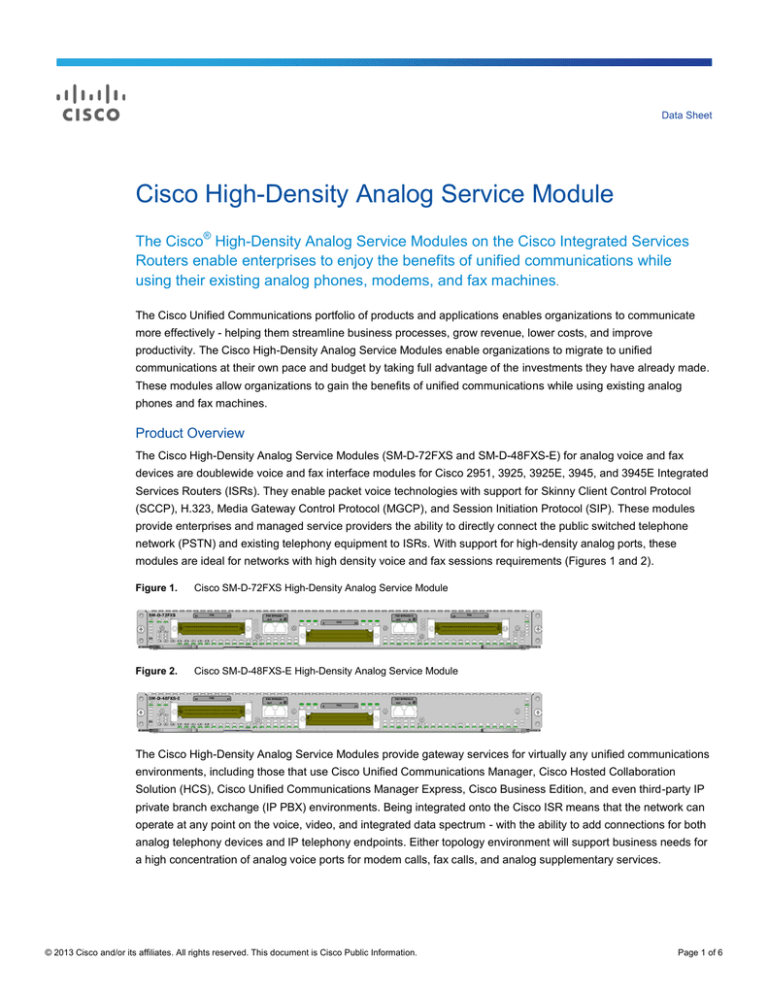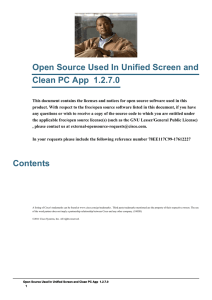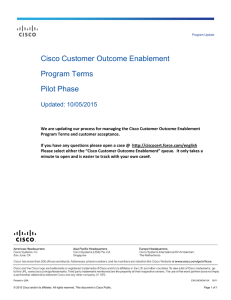
Data Sheet
Cisco High-Density Analog Service Module
The Cisco® High-Density Analog Service Modules on the Cisco Integrated Services
Routers enable enterprises to enjoy the benefits of unified communications while
using their existing analog phones, modems, and fax machines.
The Cisco Unified Communications portfolio of products and applications enables organizations to communicate
more effectively - helping them streamline business processes, grow revenue, lower costs, and improve
productivity. The Cisco High-Density Analog Service Modules enable organizations to migrate to unified
communications at their own pace and budget by taking full advantage of the investments they have already made.
These modules allow organizations to gain the benefits of unified communications while using existing analog
phones and fax machines.
Product Overview
The Cisco High-Density Analog Service Modules (SM-D-72FXS and SM-D-48FXS-E) for analog voice and fax
devices are doublewide voice and fax interface modules for Cisco 2951, 3925, 3925E, 3945, and 3945E Integrated
Services Routers (ISRs). They enable packet voice technologies with support for Skinny Client Control Protocol
(SCCP), H.323, Media Gateway Control Protocol (MGCP), and Session Initiation Protocol (SIP). These modules
provide enterprises and managed service providers the ability to directly connect the public switched telephone
network (PSTN) and existing telephony equipment to ISRs. With support for high-density analog ports, these
modules are ideal for networks with high density voice and fax sessions requirements (Figures 1 and 2).
Figure 1.
Cisco SM-D-72FXS High-Density Analog Service Module
Figure 2.
Cisco SM-D-48FXS-E High-Density Analog Service Module
The Cisco High-Density Analog Service Modules provide gateway services for virtually any unified communications
environments, including those that use Cisco Unified Communications Manager, Cisco Hosted Collaboration
Solution (HCS), Cisco Unified Communications Manager Express, Cisco Business Edition, and even third-party IP
private branch exchange (IP PBX) environments. Being integrated onto the Cisco ISR means that the network can
operate at any point on the voice, video, and integrated data spectrum - with the ability to add connections for both
analog telephony devices and IP telephony endpoints. Either topology environment will support business needs for
a high concentration of analog voice ports for modem calls, fax calls, and analog supplementary services.
© 2013 Cisco and/or its affiliates. All rights reserved. This document is Cisco Public Information.
Page 1 of 6
Features and Benefits
●
®
Cisco IOS Software-based hardware: The hardware includes uniform Cisco command-line interface (CLI)
and Simple Network Management Protocol Version 3 (SNMPv3) support for ease of gateway configuration
and operation.
●
Robust voice quality: Cisco experience in providing toll-quality packet-voice service helps ensure that the
high-density analog service modules provide clear, robust voice quality that end users have come to expect
from telephony services.
●
Investment protection: Customers can continue to use existing analog phones, fax machines, and modems
while taking advantage of unified communications. Basic analog phone connectivity is needed when the
infrastructure (wiring) or application neither supports nor requires IP phones. The analog service modules
support centralized and highly concentrated analog phone line deployments, allowing organizations to
deploy unfied communications without needing to purchase IP phones for all users.
●
Greater flexibility: These modules provide more deployment options for Cisco ISRs. They can be deployed
on existing routers and, if desired, in tandem with other applications running on that same router. This
flexibility provides greater investment protection and real estate savings.
●
Reduced barrier to entry to unified communications: The high-density analog service modules provide a
low-cost alternative for low-end analog phones and allow organizations to take advantage of unified
communications with a lower overall investment.
Analog Phone Connectivity
The Cisco High-Density Analog Service Modules are ideal for analog phone deployments ranging from centralized
to sparsely concentrated or distributed topologies. They provide a high level of availability at locations with Media
Gateway Control Protocol (MGCP) fallback and the ease of manageability using Cisco IOS Software monitoring
features. They offer many supplementary analog calling features depending on the call control and signaling type
used. Table 1 lists the supplementary analog calling features available on these modules.
Table 1.
Analog Supplementary Features Available on High-density Analog Service Modules
SCCP Features with Cisco Unified
Communications Manager
SCCP Features with Cisco Unified
Communications Manager
Express
SIP Features with Cisco Unified
Communications Manager
Basic call
X
X
X
Call forward all
X
X
Call forward busy
X
X
Call forward cancel
X
X
Call forward no answer
X
X
Call hold or resume
X
X
Call pickup group
X
X
Call pickup local
X
X
Call transfer blind
X
X
Call transfer consultative
X
X
X
Call waiting
X
X
X
Caller ID
X
X
X
Caller ID on call waiting
X
X
X
Malicious caller ID
X
© 2013 Cisco and/or its affiliates. All rights reserved. This document is Cisco Public Information.
X
Page 2 of 6
SCCP Features with Cisco Unified
Communications Manager
SCCP Features with Cisco Unified
Communications Manager
Express
SIP Features with Cisco Unified
Communications Manager
Conference call
Up to three parties
Up to three parties
Up to three parties
Impromptu conference
call
Up to three parties
Up to three parties
Meet-me conference call
X
X
Directed call park
X
Directed call pickup
X
Directed call pickup of
ringing extension
X
Redial
X
X
Speed dial
X
X
Call toggle
X
X
Music on Hold (MoH)
X
Shared-line support*
X
Shared-line privacy
X
Precedence and
preemption
X
Call back on busy
X
DC voltage visible
message waiting
indication (VMWI)
X
X
*
Simultaneous ringing, hold, and resume across analog and IP phone
The high-density analog service modules support Feature Access Codes (FAC) in conjunction with Cisco Unified
Communications Manager and Cisco Unified Communications Manager Express. Refer to documentation for these
applications details.
Fax and Modem Connectivity
The high-density analog service modules support fax machines and modems. When using fax machines, the
modules support Cisco Fax Relay, T.38 Fax Relay, and fax pass-through. Cisco and T.38 Fax Relay technologies
allow transfer of faxes across the network with high reliability using less bandwidth than a voice call. All modems
can be connected to the analog service modules and will be transferred over the network using modem passthrough.
Protocols Supported
●
SCCP
●
H.323v4
●
MGCP
●
SIP
●
Real-Time Transport Protocol (RTP)
●
Secure Real-Time Transport Protocol (SRTP)
●
Trivial File Transfer Protocol (TFTP)
●
HTTP server
●
SNMP
© 2013 Cisco and/or its affiliates. All rights reserved. This document is Cisco Public Information.
Page 3 of 6
●
Telnet
●
Dynamic Host Configuration Protocol (DHCP)
●
Domain Name System (DNS)
●
Cisco Unified Communications Manager or Cisco Unified Communications Manager Express redundancy
support using Hot Standby Router Protocol (HSRP)
●
Call survivability: MGCP failover to an H.323 connection to the Survivable Remote Site Telephony (SRST)
router
●
T.38 Fax Relay and modem pass-through
●
Codec support, G.711, and G.729a
●
RADIUS and TACACS+ for Telnet and authorization
Technical Specifications
Table 2 gives the technical specifications of the Cisco High-Density Analog Service Modules.
The high-density service module (dense wavelength division multiplexing [DWSM]) is supported on the following
platforms:
●
Cisco 3945
●
Cisco 3945e
●
Cisco 3925
●
Cisco 3925e
●
Cisco 2951
The modules can be plugged in the following DWSM slots of the following platforms:
●
On Cisco 3945 and 3945e: Only on slot 4
●
On Cisco 3925, 3925e, and 2951: Only on slot 2
Table 2.
Technical Specifications of Cisco High-Density Analog Service Modules
Category
Part no.
SM-D-72FXS and SM-D-48FXS-E
Feature Comparison of SM-D-72FXS and SM-D-48FXS-E Modules
Part No.
SM-D-72FXS
SM-D-48FXS-E
No. of foreign-exchange-station
(FXS) ports
72 (0-71)
48 (0-47)
No. of ports configurable as
FXS-Extended loop length
4 (port 0-port 3)
48 (all ports)
RJ-21 connectors
3
2
Foreign-exchange-office (FXO)
bypass ports
2
2
(FXO bypass port 0: PSTN to port 46)
(FXO bypass port 0: PSTN to port 46)
(FXO bypass port 1: PSTN to port 47)
(FXO bypass port 1: PSTN to port 47)
Compatibility
Cisco IOS Software Release
15.2(4)M2 or later
Cisco Unified Communications
Manager Version
8.6.2(SU2), 9.0.1, or later
Cisco Unified Communications
Manager Express Version
7.1, 8.0, 8.1, 8.5, 8.6, 8.8, 9.0, 9.1, or later
© 2013 Cisco and/or its affiliates. All rights reserved. This document is Cisco Public Information.
Page 4 of 6
Category
Tip and Ring Interfaces for Each FXS Port (subscriber line interface card [SLIC])
Interface type
FXS (on-premises connection only) (RJ-21)
Address signaling formats
In-band dual-tone multifrequency (DTMF)
Out-of-band pulse (8-12 pulse per second [pps])
FXS signaling formats
SM-D-72FXS and SM-D-48FXS-E support loop-start and ground-start signaling
FXS loop resistance
Up to 600 ohms (including phone or terminal equipment) for short-loop-length port
Up to 1400 ohms (including phone or terminal equipment) for long-loop-length port
On-hook voltage
-44V
Off-hook loop current
25 mA (maximum) short-loop-length port
35 mA (maximum) long-loop-length port
Ring tone
Configurable for different country requirements
Ring voltage
54 Vrms into 5REN at zero loop length (balanced) (short-loop-length port)
62 Vrms into 2REN at zero loop length (balanced) (long-loop-length port)
Ring frequency
20, 25, 30, and 50 Hz
Ring waveform
Sine wave if no DC offset
Ringer Equivalence Number
(REN) loading
5REN per port (short-loop-length port)
2REN per port (long-loop-length port)
(Max. 40 total REN load per each SM-D-72FXS module; max. 30 total REN load per each SM-D-48FXS-E
module)
RJ-11 FXS port terminating
impedance option
600c, 600r, 900c, 900r, complex1, complex2, complex3, complex4, complex5, and complex6
Disconnect supervision
Power denial (calling party control and far-end disconnect)
Caller ID
On-hook transmission of frequency-shift-keying (FSK) data
Voicemail waiting indicator
(VMWI)
FXS ports on high-speed WAN interface card (HWIC) slot supports FSK VMWI only
FXS ports on SM-D-FXS modules support both FSK and DC voltage VMWI. Default to FSK
(DC voltage VMWI is supported only with SCCP Telephony Control Application (STCAPP) protocol)
FXS loop length
Short-loop-length port 3000 ft, 26 AWG 5500 ft, 24 AWG
Long-loop-length port 11,000 ft, 26 AWG 18,000 24 AWG
Category cable
Category 3 and Category 5
Physical connector
RJ-21 and RJ-11
Certifications
Safety
● UL 60950-1
● CAN/CSA C22.2 No. 60950-1
● EN 60950-1
● AS/NZS 60950-1
● IEC 60950-1
Immunity
● EN 55024, CISPR 24
● EN50082-1
● EN 61000
EMC
● 47 CFR, Part 15
● ICES-003 Class A
● EN55022 Class A
● CISPR22 Class A
● AS/NZS 3548 Class A
● VCCI V-3
● CNS 13438
● EN 300-386
© 2013 Cisco and/or its affiliates. All rights reserved. This document is Cisco Public Information.
Page 5 of 6
Category
● TIA/EIA/IS-968
● CS-03
TELCOM
● ANSI T1.101
● ITU-T G.823, G.824
● IEEE 802.3
● RTTE Directive
● Homologation requirements vary by country and interface type. For specific country information, refer to
the online approvals database at: http://www.ciscofax.com.
This equipment complies with all the regulatory requirements for connection to the communications networks of
each country in which it is sold.
Ordering Information
To order this product, use the information provided in Table 3.
Table 3.
Ordering Information
Product Number
Product Description
SM-D-72FXS
72 Port FXS Double Wide High Density Analog Service Module
SM-D-48FXS-E
48 Port FXS OPX-Lite Double Wide High Density Analog Service Module
Services and Support
Cisco Unified Communications Services allow you to accelerate cost savings and productivity gains associated
with deploying a secure, resilient Cisco Unified Communications Solution on your network. Delivered by Cisco and
our certified partners, our portfolio of deployment and technical support services is based on proven methodologies
for unifying voice, video, data, and mobile applications on fixed and mobile networks. Our unique lifecycle
approach to these services can enhance your technology experience to enable powerful new ways to collaborate
with co-workers, partners, and customers across any workspace to accelerate business advantage.
To learn more, please visit http://www.cisco.com/go/ucservices.
For More Information
To learn more about Cisco analog gateway solutions, visit http://www.cisco.com/go/vg.
To learn more about the complete Cisco Collaboration portfolio offering, visit:
http://www.cisco.com/go/collaboration.
Printed in USA
© 2013 Cisco and/or its affiliates. All rights reserved. This document is Cisco Public Information.
C78-722469-00
01/13
Page 6 of 6



